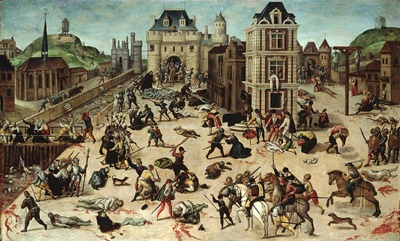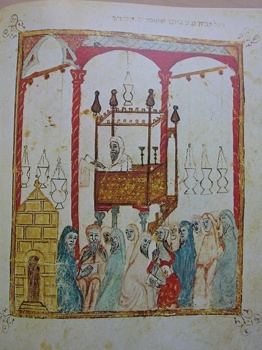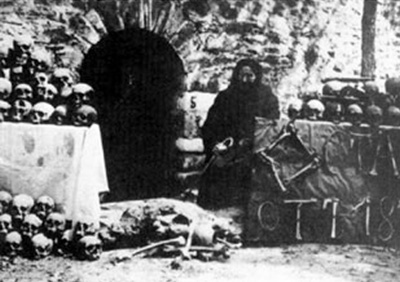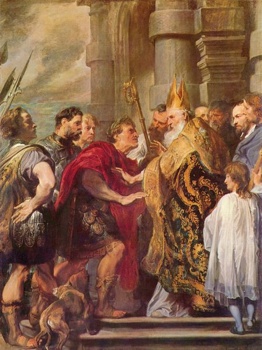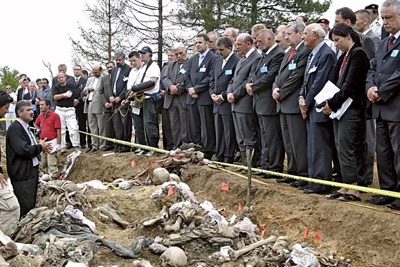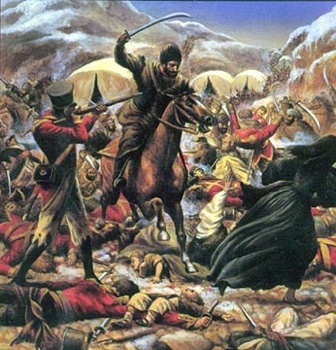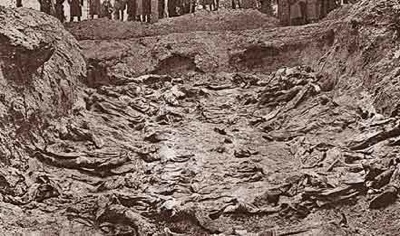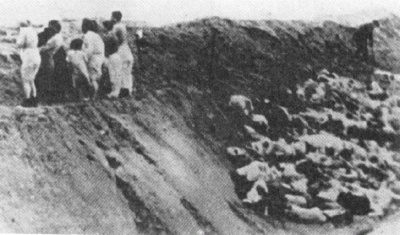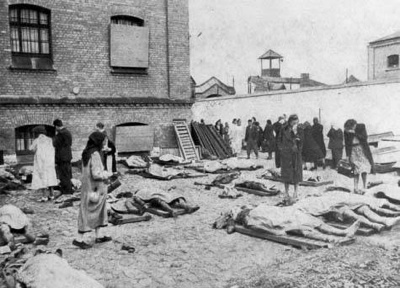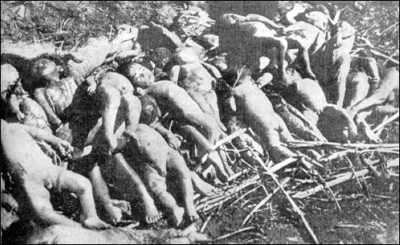The St. Bartholomew’s Day massacre (Massacre de la Saint-Barthélemy in French) was a wave of Catholic mob violence against the Huguenots (French Calvinist Protestants), during the French Wars of Religion. Traditionally believed to have been instigated by Catherine de’ Medici, the mother of King Charles IX, the massacre took place six days after the wedding of the king’s sister to the Protestant Henry of Navarre. This was an occasion for which many of the most wealthy and prominent Huguenots had gathered in largely Catholic Paris. Events began two days after the attempted assassination of Admiral Gaspard de Coligny, a Huguenot military leader. Starting on 24 August 1572 (the feast of Bartholomew the Apostle) with the murder of Coligny, the massacres spread throughout Paris, and later to other cities and the countryside, lasting for several months. The exact number of fatalities is not known, but it has been estimated that over 2000 Huguenots were killed in Paris and over 3000 in the French provinces.
This poem of Abu Ishaq, written in Al-Andalus, Granada in 1066, was considered to be largely instrumental in sparking this massacre. It contains the following lines: On December 30, 1066 (9 Tevet 4827), a Muslim mob stormed the royal palace in Granada, which was at that time in al-Andalus, assassinated Jewish vizier Joseph ibn Naghrela and massacred most of the Jewish population of the city. More than 1,500 Jewish families, numbering 4,000 persons, fell in one day. The image above shows a Jew reading the torah in Al-Andalus.
Batak massacre refers to the massacre of Bulgarians in Batak by Ottoman troops in 1876, at the beginning of the April Uprising. The number of victims varies from 3,000 to 5,000 according to different sources. On 30 April 1876, 8,000 Turkish soldiers, mainly Bashi-bazouk, led by Ahmet Aga Barun surrounded the city. After a first battle, the men from Batak decided to negotiate with Ahmet Aga. He promised them the withdrawal of his troops, under the condition of their disarmament. After the rebels had laid down their weapons, the Bashi-bazouk attacked the defenseless population. The majority of the victims were beheaded.
The Massacre of Thessaloniki was a retaliatory action by the Roman Emperor Theodosius I in 390 against the inhabitants of the Greek city of Thessaloniki, who had risen in revolt. The cause of the uprising was the order to arrest a popular wagon driver for trying to seduce and have sex with a servant of the emperor (Butherich). The wagon driver was locked up in prison, but the citizens of Thessaloniki demanded his release. Butherich was murdered in the following turmoil, and so the Emperor intervened and ordered executions. However, the command was too little too late, and in the hippodrome in Thessaloniki angry Gothic troops massacred 7,000 people – the number is probably exaggerated, but gives a sense of the scale of the massacre. This incident aroused the wrath of the Bishop of Milan, Ambrose, and the church urged the emperor to repentance.
The Srebrenica Massacre, also known as Srebrenica Genocide, was the July 1995 killing of an estimated 8,000 Bosniak men, including at least 500 children in the region of Srebrenica in Bosnia and Herzegovina by units of the Army of Republika Srpska (VRS) under the command of General Ratko Mladic during the Bosnian War. In addition to the VRS, a paramilitary unit from Serbia known as the Scorpions participated in the massacre. So far, more than 5,600 victims of genocide have been identified through DNA analysis. Prior to the genocide, the United Nations had declared Srebrenica a UN protected “safe area”, but that did not prevent the massacre, even though 400 armed Dutch peacekeepers were present at the time. After reviewing a comprehensive report, the Dutch government resigned over this matter in 2002.
The Massacre of Elphinstone’s Army was a victory of Afghan forces led by Akbar Khan, the son of Dost Mohammad Khan, over a combined British and Indian force led by William Elphinstone in January 1842. After the British and Indian troops captured Kabul in 1839, an Afghan uprising forced the occupying garrison out of the city. The British army, consisting of 4,500 troops and 12,000 working personnel or camp-followers, left Kabul on January 6, 1842. They attempted to reach the British garrison at Jalalabad, 90 miles away, but were immediately harassed by Afghan forces. The last remnants were eventually annihilated near Gandamak on January 13. Only one man, the assistant surgeon William Brydon, survived and managed to reach Jalalabad.
The Katyn massacre, also known as the Katyn Forest massacre, was a mass execution of Polish military officers, policemen and civilian prisoners of war ordered by Soviet authorities on March 5, 1940. The number of victims is estimated at about 22,000, with the most commonly cited number of 21,768. The victims were murdered in the Katyn forest in Russia, the Kalinin (Tver) and Kharkiv prisons and elsewhere. About 8,000 were officers taken prisoner during the 1939 Soviet invasion of Poland, the rest being Poles arrested for allegedly being “intelligence agents, gendarmes, spies, saboteurs, landowners, factory owners, lawyers, priests, and officials.” Since Poland’s conscription system required every non-exempted university graduate to become a reserve officer,the Soviets were able to round up much of the Polish intelligentsia, and the Jewish, Ukrainian, Georgian and Belarusian intelligentsia of Polish citizenship.
Babi Yar is a ravine in Kiev, the capital of Ukraine. In the course of two days, September 29 and 30, 1941, a special team of German Nazi SS supported by other German units, local collaborators and Ukrainian police murdered 33,771 Jewish civilians. The Babi Yar massacre is considered to be the largest single massacre in the history of the Holocaust.
The massacre of prisoners refers to a series of mass executions committed by the Soviet NKVD against prisoners in Poland, the Baltic states, and parts of the Soviet Union from which the Red Army was withdrawing after the German invasion in 1941. The overall death toll is estimated at around 100,000, including more than 10,000 in Western Ukraine.
The Nanking Massacre, commonly known as the Rape of Nanking, was an infamous war crime committed by the Japanese military in Nanjing (Nanking), then the capital of the Republic of China, after it fell to the Imperial Japanese Army on December 13, 1937. The duration of the massacre is not clearly defined, although the violence lasted well into the next six weeks, until early February 1938. During the occupation of Nanking, the Japanese army committed numerous atrocities, such as rape, looting, arson and the execution of prisoners of war and civilians. Although the executions began under the pretext of eliminating Chinese soldiers disguised as civilians, it is claimed that a large number of innocent men were intentionally misidentified as enemy combatants and executed as the massacre gathered momentum. A large number of women and children were also killed, as rape and murder became more widespread. According to the International Military Tribunal for the Far East, estimates made at a later date indicate that the total number of civilians and prisoners of war murdered in Nanking and its vicinity during the first six weeks of the Japanese occupation was over 200,000. That these estimates are not exaggerated is borne out by the fact that burial societies and other organizations have counted more than 155,000 buried bodies. This article is licensed under the GFDL because it contains quotations from Wikipedia. Contributor: abhishek
